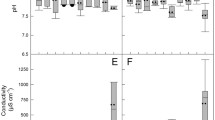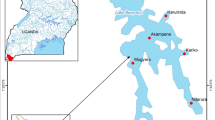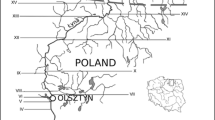Abstract
We assessed the incidence of faecal-indicator bacteria in Tyume River over a 12-month period between August 2010 and July 2011. Total coliforms, faecal coliforms and enterococci were determined by the membrane filtration method. Total coliforms were detected in counts ranging from 2.1 × 102 to 3.4 × 104 CFU/100 ml. Faecal coliform counts ranged from 1 × 102 to 1.6 × 104 CFU/100 ml while enterococci counts were in the range of 3.3 × 101 to 5.1 × 103 CFU/100 ml. Indicator bacteria counts increased from upstream to downstream sampling sites. Counts of indicator bacteria at all sites were significantly affected by seasonal changes. The bacteriological qualities of the river water were poor, exceeding the guideline of 200 CFU/100 ml and 33 CFU/100 ml for faecal coliforms and enterococci, respectively, for recreational water. Faecal coliform counts also exceeded the 1,000 CFU/100 ml guideline for water used in fresh produce irrigation. Microbial source tracking results showed that faecal pollution was predominantly of human origin during spring at all sampling sites. During other seasons, human faecal pollution was largely confined to midstream and downstream sampling sites. Generally, the presence of faecal-indicator bacteria in the river water samples suggests faecal pollution of this freshwater resource, raising the possibility of the presence of pathogenic microorganisms in the water and a threat to public health.








Similar content being viewed by others
References
Adewoye, S. O. (2010). Effects of detergent effluent discharges on the aspect of water quality of ASA River, Ilorin, Nigeria. Agriculture and Biology Journal of North America, 1(4), 731–736.
Afshin, J., & Saeid, S. (2011). Faecal coliforms and faecal streptococci contamination of traditional Ice cream in Tabriz. American-Eurasian Journal of Agriculture and Environmental Science, 11(6), 812–814.
Ahmed, W., Neller, R., & Katouli, M. (2006). Population similarity of enterococci and Escherichia coli in surface waters: a predictive tool to trace the sources of faecal contamination. Journal of Water and Health. doi:10.2166/wh.2006.042.
Ahmed, W., Goonetilleke, A., & Gardner, T. (2010). Human and bovine adenoviruses for the detection of source-specific faecal pollution in coastal waters in Australia. Water Research. doi:10.1016/j.watres.2010.05.017.
Alm, E. W., Burke, J., & Spain, A. (2003). Faecal indicator bacteria are abundant in wet sand at freshwater beaches. Water Research, 37, 3978–3982.
Ashbolt, N. J., Grabow, W. O. K., & Snozzi, M. (2001). Indicators of microbial water quality. In: L. Fewtrell & J. Bartram (Eds.), Water quality: guidelines, standards and health-assessment of risk and risk management for water-related infectious disease. WHO Water Series (pp. 289–315). London: IWA Publishing. http://www.who.int/water_sanitation_health/dwq/iwachap13.pdf. Accessed 13 May 2012.
Baudišová, D. (2009). Microbial pollution of water from agriculture. Plant and Soil Environment, 55(10), 429–435.
Bernier, J.-L. T., Maheux, A. F., Boissinot, M., Picard, F. J., Bissonnette, L., Martin, D., et al. (2009). Onsite microbiological quality monitoring of raw source water in Cree community of Mistissini. Water Quality Research Journal of Canada, 44(4), 345–354.
Bhandaram, U., Guerra, A., Robertson, B., Slattery, H., & Tran, K. (2011). Effect of urban runoff on water quality indicators in Ballona Creek, CA. UCLA Senior Practicum in Environmental Science. UCLA Institute of the Environment and Sustainability (pp. 1–28). http://www.environment.ucla.edu/405F298C-4811-4710-807E-C323E12BFEED/FinalDownload/DownloadId-2423B48290426FF39CB6AD0F363DF680/405F298C-4811-4710-807E-C323E12BFEED/media_IOE/files/Effect-of-Urban-Runoff-ms-ncg.pdf. Accessed 20 May 2012.
Cabral, J. P. S. (2010). Water microbiology. Bacterial pathogens and water. International Journal of Environmental Research and Public Health, 7, 3657–3703. doi:10.3390/ijerph7103657.
Carroll, S.P., Dawes, L.A., Ashantha, G., Megan, H. (2006). Water quality profile of an urbanising catchment—Ningi Creek Catchment. Technical Report, School of Urban Development, Queensland University of Technology. Caboolture Shire Council (1–93).
CDC (2009). Investigation of an outbreak of Salmonella Saintpaul infections linked to raw Alfalfa sprouts. Update for May 8, 2009. Atlanta, GA: Centers for Disease Control and Prevention. http://www.cdc.gov/Salmonella/saintpaul/. Accessed 20 May 2012.
Copeland, C., Beers, B., Thompson, M., Pinkerton, R., Barrett, L., Sevilleja, E. J., et al. (2009). Faecal contamination of drinking water in a Brazilian shanty town: importance of household storage and new human faecal marker testing. Journal of Water and Health, 7(2), 324–331.
Cronin, A. A., Shrestha, D., Cornier, N., Abdalla, F., Ezard, N., & Aramburu, C. (2008). A review of water and sanitation provision in refugee camps in association with selected health and nutrition indicators—the need for integrated service provision. Journal of Water and Health, 6, 1–13.
Department of Water Affairs and Forestry (DWAF) (1996). South African Water Quality Guidelines (2nd edn.). Volume 4: Agricultural Use: Irrigation. (pp. 1–194). Pretoria: Department of Water Affairs and Forestry. http://www.dwaf.gov.za/iwqs/wq_guide/Pol_saWQguideFRESH_vol4_Irrigation.pdf. Accessed 11 May 2012.
Djuikom, E., Njine, T., Nola, M., Sikati, V., & Jugnia, L.-B. (2006). Microbiological water quality of the Mfoundi River watershed at Yaounde´, Cameroon, as inferred from indicator bacteria of faecal contamination. Environmental Monitoring and Assessment, 122, 171–183.
Do, T. T., Bui, T. T., Mølbak, K., Phung, D. C., & Dalsgaard, A. (2007). Epidemiology and aetiology of diarrhoeal diseases in adults engaged in wastewater-fed agriculture and aquaculture in Hanoi, Vietnam. Tropical Medicine & International Health, 12(2), 23–33.
Dombek, P. E., Johnson, L. K., Brown, M. B., & Sadowsky, M. J. (2000). Use of repetitive DNA sequences and the PCR to differentiate Escherichia coli isolates from human and animal sources. Applied and Environmental Microbiology, 66, 2572–2577.
Drechsel, P., Graefe, S., Sonou, M., & Cofie, O. O. (2006). Informal irrigation in urban West Africa: an overview (pp. 1–34). Colombo: International Water Management Institute. IWMI Research Report 102.
Evanson, M., & Ambrose, R. (2006). Sources and growth dynamics of faecal indicator bacteria in a coastal wetland system and potential impacts to adjacent waters. Water Research Journal, 40, 475–486.
eWISA (2012). Microbial quality: total coliforms. http://www.ewisa.co.za/eWISAWaterworks/misc/DrinkingWaterQuality/defaultwqTC.htm. Accessed 23/05/2012.
Frenzel, S. A., & Couvillion, C. S. (2002). Faecal-indicator bacteria in streams along a gradient of residential development. Journal of American Water Research Association, 38(1), 265–273.
Fries, J. S., Characklis, G. W., & Noble, R. T. (2008). Sediment–water exchange of Vibrio sp. and faecal indicator bacteria: implications for persistence and transport in the Neuse River Estuary, North Carolina, USA. Water Research, 42, 941–950.
Gemmell, M. E., & Schmidt, S. (2010). Potential links between irrigation water quality and microbiological quality of food in subsistence farming in KwaZulu-Natal, South Africa. In: A. Mendez-Vilas (Ed.), Current Research, Technology and Education Topics in Applied Microbiology and Microbial Biotechnology (pp. 1190–1195). http://www.formatex.info/microbiology2/1190-1195.pdf. Accessed 14 June 2012.
Gillespie, I. A. (2004). Outbreak of Salmonella Newport infection associated with lettuce in the UK. Eurosurveillance., 8, 25–62.
Griffin, D. W., Donalson, K. A., Paul, J. H., & Rose, J. B. (2003). Pathogenic human viruses in coastal waters. Clinical Microbiology Reviews, 16, 129–143.
Hagedorn, C., Robinson, S. L., Filtz, J. R., Grubbs, S. M., Angier, T. A., & Reneau, R. B., Jr. (1999). Determining sources of faecal pollution in a rural Virginia watershed with antibiotic resistance patterns in faecal streptococci. Applied and Environmental Microbioloy, 65, 5522–5531.
Haile, R. W., Witte, J. S., & Gold, M. (1999a). The health effects of swimming in ocean water contaminated by storm drain runoff. Epidemiology, 10(1), 355–363.
Haile, R. W., Witte, J. S., Gold, M., Cressey, R., McGee, C., Millikan, R. C., et al. (1999b). The health effects of swimming in ocean water contaminated by storm drain runoff. Epidemiology, 10(1), 355–363.
Holland, A. F., Sangera, D. M., Gawlea, C. P., Lerberg, S. B., Santiago, S. M., Riekerk, G. H. M., et al. (2004). Linkages between tidal creek ecosystems and the landscape and demographic attributes of their watersheds. Jornal of Experimental Marine Biology and Ecology, 298, 151–178.
UFH Interstudy (2012). Available at: http://www.interstudy.org/u/2-university-of-fort-hare. Accessed 21/04/2012.
Kavka, G., Poetsch, E. (2002). Microbiology. In: Joint Danube Survey—technical report of the International Commission for the Protection of the Danube River (pp. 138–150).
Kelsey, H., Porter, D. E., Scott, G., Neet, M., & White, D. (2004). Using geographic information systems and regression analysis to evaluate relationships between land use and faecal coliform bacterial pollution. Jornal of Experimental Marine Biology and Ecology, 2(8), 197–209.
Kolarević, S., Knežević-Vukčević, J., Paunović, M., Gačić, Z., & Vuković-Gačić, B. (2011). Assessment of the microbiological quality of the River Tisa in Serbia. Water Research and Management, 1(2), 57–61.
Kreader, C. A. (1995). Design and evaluation of bacteroides DNA probes for the specific detection of human faecal pollution. Applied and Environmental Microbiology, 61, 1171–1179.
National Health and Medical Research Council, (2008). Guidelines for Managing Risks in Recreational Water. http://www.nhmrc.gov.au. Accessed 24/03/2012.
Morace, J. L., & McKenzie, S. W. (2002). Faecal-indicator bacteria in the Yakima River Basin, Washington—an examination of 1999 and 2000 synoptic-sampling data and their relation to historical data. Water-Resources Investigations Report, 02–4054, 1–44.
Nevondo, T. S., & Cloete, T. E. (1999). Bacterial and chemical quality of water supply in the Dertig village settlement. Water SA, 25(2), 215–220.
Obi, C. L., Potgieter, N., Bessong, P. O., & Matsaung, G. (2002). Assessment of the microbial quality of river water sources in rural Venda communities in South Africa. Water SA, 28(3), 287–292.
Obi, C. L., Potgieter, N., Bessong, P. O., & Matsaung, G. (2003). Scope of potential bacterial agents of diarrhoea and microbial assessment of quality of river water sources in rural Venda communities in South Africa. Water Science and Technology, 47, 59–64.
Oswald, W. E., Lescano, A. G., Bern, C., Calderon, M. M., Cabrera, L., & Gilman, R. H. (2007). Faecal contamination of drinking water within peri-urban households, Lima, Peru. The American Journal of Tropical Medicine and Hygiene, 77, 699–704.
Pitt, R. (1998). Epidemiology and stormwater management. Stormwater quality management. New York: CRC.
Raschid-Sally, L., Carr, R., & Buechler, S. (2005). Managing wastewater agriculture to improve livelihoods and environmental quality in poor countries. Irrigation and Drainage, 54, S11–S22.
Servais, P., Billen, G., Goncalves, A., & Garcia-Armisen, T. (2007). Modelling microbiological water quality in the Seine river drainage network: past, present and future situations. Hydrology and Earth System Science, 11, 1581–1592.
Shilklomanov, I. A. (2000). Appraisal and assessment of World Water Resources. Water International, 25(1), 11–32.
Sinton, L. W., Finlay, R. K., & Hannah, D. J. (1998). Distinguishing human from animal faecal contamination in water: a review. New Zealand Journal of Marine and Freshwater Research, 32(2), 323–348.
Sivapalasingam, S., Friedman, C. R., Cohen, L., & Tauxe, R. V. (2004). Fresh produce: a growing cause of outbreaks of foodborne illness in the United States, 1973 through 1997. Journal of Food Protection, 67, 2342–2353.
Standard Methods. (2005). Standard methods for the examination of water and wastewater (20th ed.). Washington DC: American Public Health Association (APHA).
Teunis, P., Takumi, K., & Shinagawa, K. (2004). Dose response for infection by Escherichia coli O157:H7 from outbreak data. Risk Analysis, 24(2), 401–407.
Toze, S. (1998). PCR and the detection of microbial pathogens in water and wastewater. Water Research, 33(17), 3545–3556.
Toze, S. (2006). Water reuse and health risks—real vs. perceived. Desalination, 187, 41–51.
USEPA (2012). Water: Monitoring and analysis. http://water.epa.gov/type/rsl/monitoring/vms511.cfm. Accessed 04/05/2012.
Wilhelm, L. J., & Maluk, T. L. (1998). Faecal-indicator bacteria in surface waters of the Santee River Basin and coastal drainages, North and South Carolina, 1995–98. USGS FS. http://pubs.usgs.gov/fs/1998/fs085-98/. Accessed 14 June 2012.
Young, K. D., & Thackston, E. L. (1999). Housing density and bacterial loading in urban streams. Journal of Environmental Engineering, 125, 1177–1180.
Acknowledgments
The authors wish to express their gratitude to the Water Research Commission (WRC) of South Africa for funding this research.
Author information
Authors and Affiliations
Corresponding author
Rights and permissions
About this article
Cite this article
Sibanda, T., Chigor, V.N. & Okoh, A.I. Seasonal and spatio-temporal distribution of faecal-indicator bacteria in Tyume River in the Eastern Cape Province, South Africa. Environ Monit Assess 185, 6579–6590 (2013). https://doi.org/10.1007/s10661-012-3048-4
Received:
Accepted:
Published:
Issue Date:
DOI: https://doi.org/10.1007/s10661-012-3048-4




